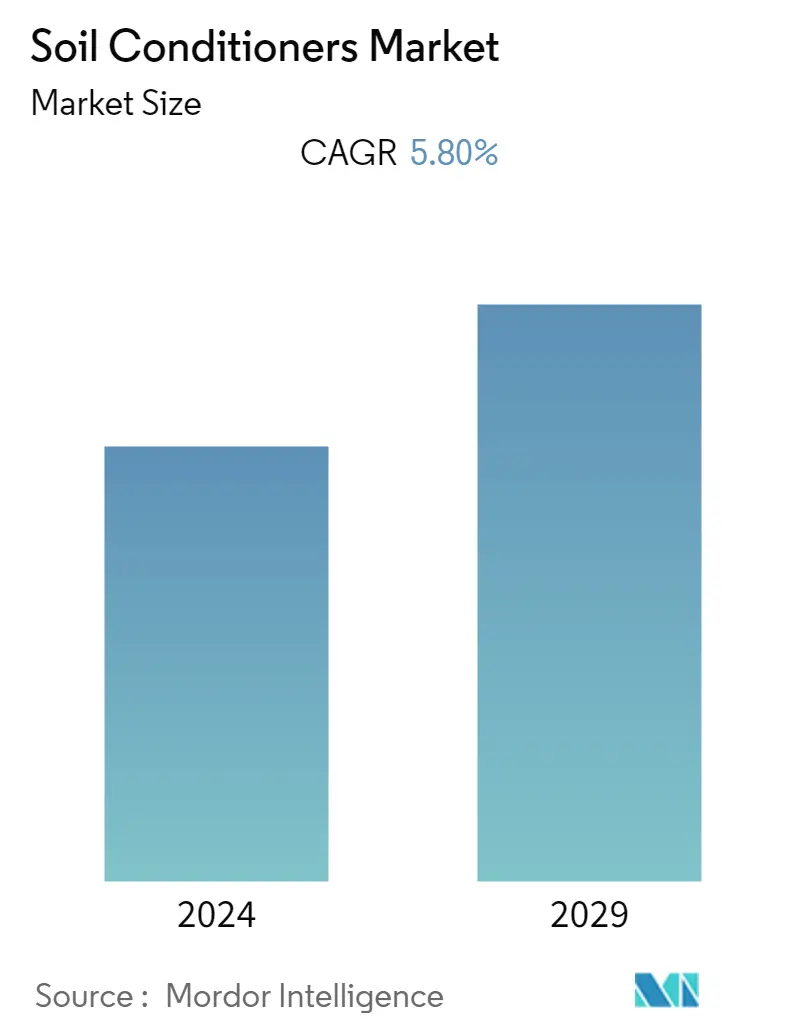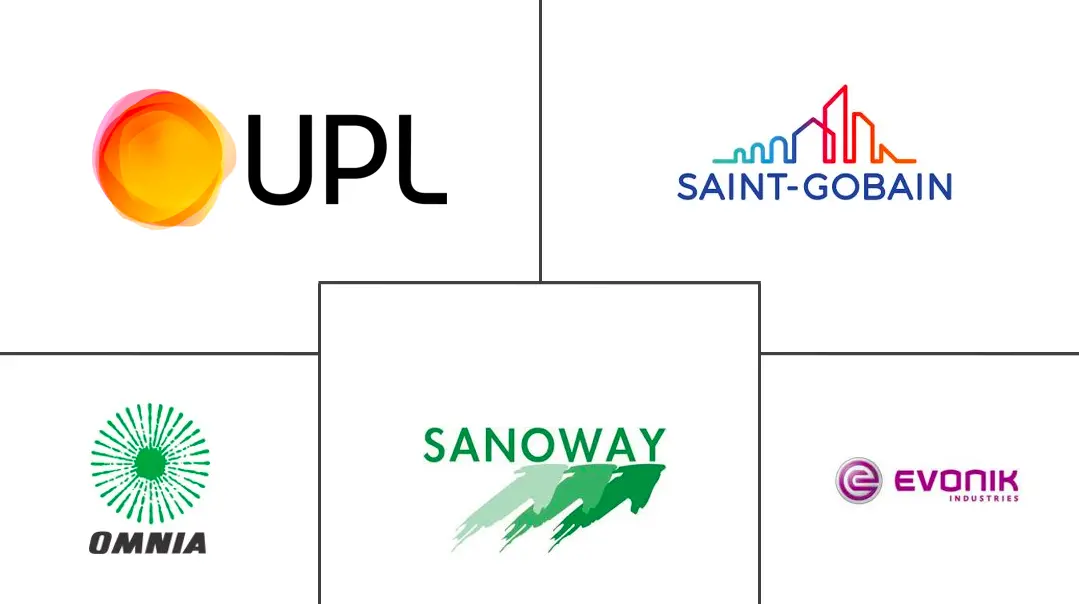Market Size of Soil Conditioners Industry

| Study Period | 2019 - 2029 |
| Base Year For Estimation | 2023 |
| CAGR | 5.80 % |
| Fastest Growing Market | Europe, Middle-East and Africa |
| Largest Market | Asia Pacific |
| Market Concentration | Low |
Major Players
*Disclaimer: Major Players sorted in no particular order |
Soil Conditioners Market Analysis
The global soil conditioners market is projected to register a CAGR of 5.8% during the forecast period.
- Due to the intensive use of fertilizers, soil degradation has become a global problem, leading to the depletion of organic matter and soil fertility. Meanwhile, the intensification of agriculture accompanied by urbanization and industrialization has drastically accelerated the waste generation rate.
- For instance, coal mining produces wastes in large quantities globally, most of which end up in landfills or dump into storage dams. Accordingly, sustainable food production is driving global innovations to utilize various waste materials better to make value-added products, such as soil conditioners.
- Nowadays, soil conditioners are important in improving plant growth and soil health and reducing chemical fertilizer use. For instance, Phosphorus run-off from agriculture fields in southern Finland is the largest threat to water quality and living marine resources in this area of the Baltic Sea, and traditional farming methods have proven inadequate. So, using gypsum as a soil amendment on agricultural fields will reduce run-off pollution by 50%, decrease demand for virgin-mined phosphorus, and reuse industrial waste. This will encourage the growth of the market in the coming years.
- Soil management is an increasingly important global issue. According to Food and Agriculture Organization (FAO), 38% of global soil has been degraded, which causes the loss of soil organic matter, salinity, acidity, or alkalinity, and a decline in fertility. The degradation of soil conditions and structure, the need for food security, and enhanced nutrient management in the soil are some factors driving the market growth for soil conditioners in the coming years.
Soil Conditioners Industry Segmentation
A soil conditioner is a product that is added to soil to improve the soil's physical qualities; usually, its fertility and structure are considered.
The soil conditioners market is segmented by product type (organic (compost, green and farmyard manure, peat, and others) and inorganic (polymers and gypsum)) and geography (North America, Europe, South America, Asia Pacific, and Africa).
The report offers the market size and forecasts in value in (USD million) for all the above segments.
| Product Type | ||||||
| ||||||
|
| Geography | |||||||||
| |||||||||
| |||||||||
| |||||||||
| |||||||||
|
Soil Conditioners Market Size Summary
The soil conditioners market is experiencing significant growth, driven by the need to combat soil degradation caused by intensive fertilizer use, urbanization, and industrialization. As agriculture intensifies, the generation of waste materials has increased, prompting innovations to repurpose these wastes into value-added products like soil conditioners. These products are essential for enhancing plant growth, improving soil health, and reducing reliance on chemical fertilizers. The degradation of soil conditions, coupled with the need for food security and better nutrient management, is propelling the demand for soil conditioners. The use of amendments such as gypsum is helping to address environmental issues like phosphorus run-off, further supporting market expansion.
In regions like Asia-Pacific, where fertile lands face severe degradation due to frequent cropping, soil conditioners are becoming crucial in replenishing nutrient-depleted soils. Traditional practices, such as the use of organic manures in countries like India, are being supplemented with modern soil conditioning solutions to meet the growing food demand. The market is characterized by a high level of fragmentation, with numerous local and international players like UPL Limited and Saint-Gobain Group actively innovating and expanding their product offerings. Strategic moves such as acquisitions and partnerships are common as companies strive to capture a larger market share and address specific soil challenges in various regions.
Soil Conditioners Market Size - Table of Contents
-
1. MARKET DYNAMICS
-
1.1 Market Overview
-
1.2 Market Drivers
-
1.3 Market Restraints
-
1.4 Porter's Five Forces Analysis
-
1.4.1 Bargaining Power of Buyers
-
1.4.2 Bargaining Power of Suppliers
-
1.4.3 Threat of New Entrants
-
1.4.4 Threat of Substitute Products
-
1.4.5 Intensity of Competitive Rivalry
-
-
-
2. MARKET SEGMENTATION
-
2.1 Product Type
-
2.1.1 Organic
-
2.1.1.1 Compost
-
2.1.1.2 Green and Farmyard Manure
-
2.1.1.3 Peat
-
2.1.1.4 Other Organic Types
-
-
2.1.2 Inorganic
-
2.1.2.1 Polymers
-
2.1.2.2 Gypsum
-
-
-
2.2 Geography
-
2.2.1 North America
-
2.2.1.1 United States
-
2.2.1.2 Canada
-
2.2.1.3 Mexico
-
2.2.1.4 Rest of North America
-
-
2.2.2 Europe
-
2.2.2.1 Spain
-
2.2.2.2 United Kingdom
-
2.2.2.3 France
-
2.2.2.4 Germany
-
2.2.2.5 Italy
-
2.2.2.6 Russia
-
2.2.2.7 Rest of Europe
-
-
2.2.3 Asia Pacific
-
2.2.3.1 China
-
2.2.3.2 India
-
2.2.3.3 Japan
-
2.2.3.4 Australia
-
2.2.3.5 Rest of Asia Pacific
-
-
2.2.4 South America
-
2.2.4.1 Brazil
-
2.2.4.2 Argentina
-
2.2.4.3 Rest of South America
-
-
2.2.5 Africa
-
2.2.5.1 South Africa
-
2.2.5.2 Rest of Africa
-
-
-
Soil Conditioners Market Size FAQs
What is the current Soil Conditioners Market size?
The Soil Conditioners Market is projected to register a CAGR of 5.80% during the forecast period (2024-2029)
Who are the key players in Soil Conditioners Market?
UPL Limited, Saint-Gobain Group, Omnia Holdings Limited, Sanoway GmbH and Evonik Industries AG are the major companies operating in the Soil Conditioners Market.

